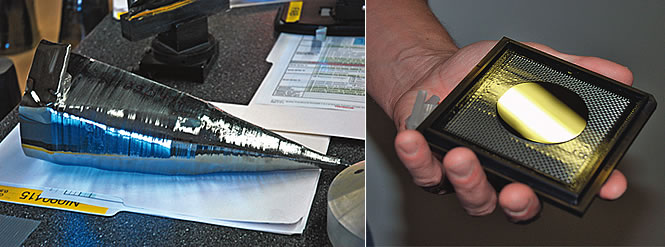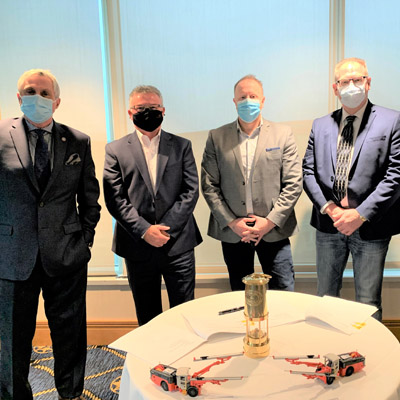Seeing infrared
Firebird Technologies Inc. creates indium antimonide wafers—and has plans to supply more products to the solar market

This indium antimonide crystal (L) will be used to make polished indium anitmonide wafers such as this one (R), which is destined for use in infrared detection systems. — Tanya Laing Gahr photos
What can you do in eight to 10 weeks? You could enjoy school summer holidays or cycle across Canada—or, if you’re working for Firebird Technologies Inc., you could purify indium, compound it with antimony and grow indium antimonide (InSb) crystals for a number of niche markets.
Based in Trail, British Columbia, Firebird Technologies is a division of 5N Plus Inc. (TSX:VNP). The company receives an indium supply from the nearby Teck Metals Ltd. (TSX:TCK.A), one of the largest indium suppliers in the world. By combining indium with antimony, Firebird creates upwards of 3,500 InSb wafers annually. Applications of the wafers include firefighting, infrared optics and health care.
Growing the crystals requires the compound to be ultra-pure. Don Freschi, the CEO of Firebird Technologies, said that the indium is purified in-house to a 695 level, and the antimony to between 695 and 795, before they are compounded and zoned. After zoning, the poly-InSb is at an 89 purity level.
“What we do then is put that material, the really clean stuff, into a crystal puller,” said Freschi. “We pull a single crystal from it, so we arrange the atoms so they all line up perfectly in the crystal puller.”
Firebird uses the Hall measurement system to assure ultra-purity, before slicing the crystals into wafers and polishing the resulting wafers to an ultra-flat state.
Gloves and gown a must
InSb is a safe, inert compound, requiring specialized gloves and gowning to keep it pure. Freschi said that the crucial point in the process comes when the crystals are being grown.
“During the crystal growth, you’re playing with science,” he said. “You’re trying to make something work and you’re forcing it to grow single, so it’s more of an art than a science.”
Firebird has also been branching into the germanium market, and has signed contracts with Teck to process Teck’s supply of raw germanium. Freschi said there is demand for a North American source of germanium.
“We are ready to take on that big solar market—we have access to indium, potentially gallium, and we do selenium in Montreal,” said Freschi. “I think we’re sitting very well, especially on the solar side.”




